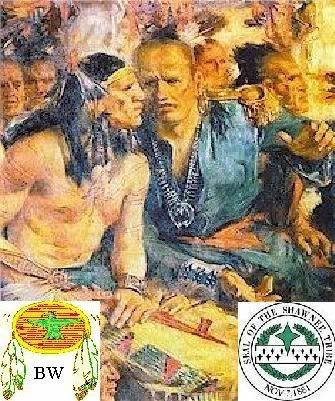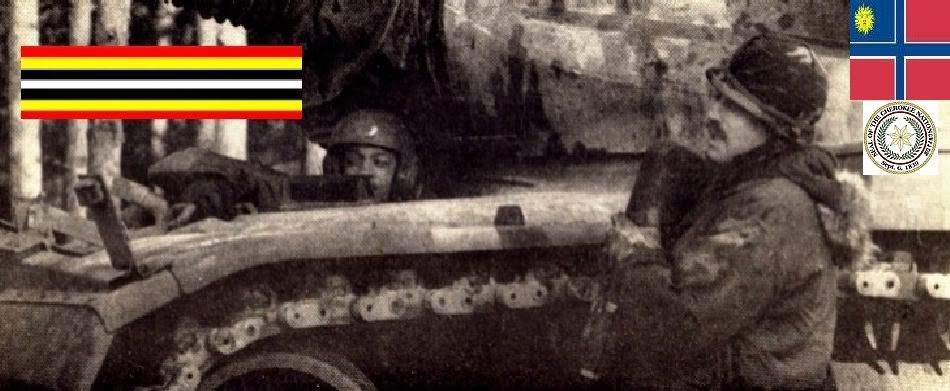|

Chief Blue Jacket
(1745-1810)
Warriors Citation
Blue Jacket was a Shawnee leader who opposed white encroachment and fought against white expansion. In 1778 he and his men
captured Daniel Boone during a Kentucky raid. On August 20, 1794 he led Native people at the Battle of Fallen Timbers against
General Anthony Wayne where he was defeated. The result was the Treaty of Greenville (1795) and over half of Ohio was ceded
to the Americans. Blue was known for his militant defense of Shawnee lands in the Ohio Country. Perhaps the preeminent American
Indian leader in the Northwest Indian War, in which a pan-tribal confederacy fought several battles with the nascent United
States, he was an important predecessor of the famous Shawnee leader Tecumseh. Little is known of Blue Jacket's early life.
He first appears in written historical records in 1773, when he was already a grown man and a war chief. In that year, a British
missionary visited the Shawnee villages on the Scioto River and recorded the location of Blue Jacket's Town on Deer Creek
(present Ross County, Ohio).

In 1877, decades after Blue Jacket's death, a story was published which claimed that he was in fact a white man named Marmaduke
Van Swearingen, who had been captured and adopted by Shawnees in the 1770s, around the time of the American Revolutionary
War. This story, popularized in historical novels written by Allan W. Eckert in the late 1960s, remains well known in Ohio,
where an outdoor drama celebrating the life of the white Indian chief is performed each year in Xenia, Ohio. Despite the persistence
of this tale, many have questioned its authenticity. Historians such as Reginald Horsman, Helen Hornbeck Tanner, and Blue
Jacket biographer John Sugden have argued that the known historical facts about Blue Jacket and Van Swearingen make it unlikely
that they were the same person. The historical record indicates that Blue Jacket was much older than Marmaduke Van Swearingen
and was already an established chief by the time that Van Swearingen was supposedly captured. Furthermore, no one who personally
knew Blue Jacket left any records referring to him as a white man. According to Sugden, Blue Jacket was undoubtedly a Shawnee
by birth. DNA testing of the descendants of Blue Jacket and Van Swearingen has given additional support to the argument that
Blue Jacket was not Van Swearingen. After an initial test in 2000, results of a DNA test using updated equipment and techniques
was published in the September 2006 edition of The Ohio Journal of Science. The researchers tested DNA samples from four men
descended from Charles Swearingen, Blue Jacket's supposed brother, and six who are descended from Blue Jacket's son George
Blue-Jacket. The DNA from the two families did not match, and so the study concluded that, "Barring any questions of the paternity
of the Chief's single son who lived to produce male heirs, the 'Blue Jacket with-Caucasian-roots' is not based on reality."
Blue Jacket participated in Dunmore's War and the American Revolutionary War (allied with the British), always attempting
to maintain Shawnee land rights. With the British defeat in the American Revolutionary War, the Shawnee lost valuable assistance
in defending the Ohio Country. The struggle continued as white settlement in Ohio escalated, and Blue Jacket was a prominent
leader of the resistance. On November 3, 1791, the army of a confederation of Indian tribes, led by Blue Jacket and Miami
Chief Little Turtle, defeated an American expedition led by Arthur St. Clair, governor of the Northwest Territory. The engagement,
known as the Battle of the Wabash or as St. Clair's Defeat, was the crowning achievement of Blue Jacket's military career,
and the most severe defeat ever inflicted upon the United States by Native Americans. Traditional accounts of the battle tend
to give most of the credit for the victory to Little Turtle. John Sugden argues that Little Turtle's prominence is due in
large measure to Little Turtle's self-promotion in later years. Blue Jacket's triumph was short-lived. The Americans were
alarmed by St. Clair's disaster and raised a new professional army, commanded by General Anthony Wayne. On August 20, 1794,
Blue Jacket's confederate army clashed with Wayne at the Battle of Fallen Timbers, just south of present-day Toledo, Ohio.
Blue Jacket's army was defeated, and he was compelled to sign the Treaty of Greenville on August 3, 1795, ceding much of present-day
Ohio to the United States. In 1805, Blue Jacket also signed the Treaty of Fort Industry, relinquishing even more of Ohio.
In Blue Jacket's final years, he saw the rise to prominence of Tecumseh, who would take up the banner and make the final attempts
to reclaim Shawnee lands in the Ohio Country. From: historical accounts & records


LINK TO BRAVEHORSE WARRIORS VOLUME TWO
|

